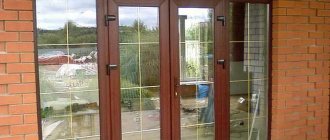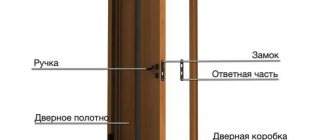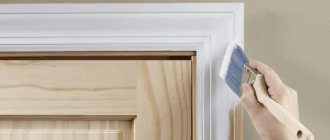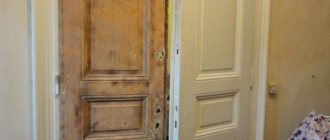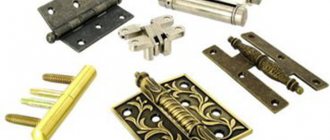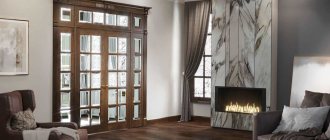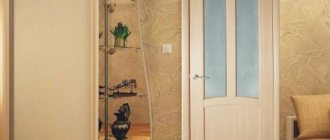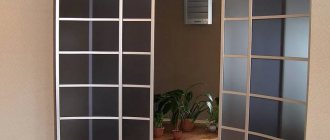Decorating doors on your own is not only an opportunity to disguise individual defects on the door leaf that appear during long-term use, but also a unique way to transform your living space. If the door has retained its strength and functionality, and only its aesthetics have suffered, then, in order to save money, you can not buy a new one, but limit yourself to restoration.
It is possible to give new life to old doors with the help of non-standard design using decorative materials. Such a solution will look quite decent, of course, if executed well.
What interior doors can be covered?
In general, any room doors can be put in order, with the exception of the cheapest, low-quality ones and those that are seriously damaged, so much so that they have lost their structural strength. If it is necessary to change not only the coating, but also a significant part of the structure, it is not advisable to carry out work on gluing such a surface.
Typically, they decide to glue interior doors when they no longer fit into the interior (for example, after cosmetic repairs) or to renew the door leaf, which has lost its original “marketable” appearance after long-term use:
- the paint on the door has peeled off in places or has scuff marks;
- there are defects in the wood or veneer covering;
- cracks and chips formed.
Video description
If you are wondering whether it is possible to restore interior doors that are over a hundred years old, watch this video:
Restoring cracked panel doors
If the panels dangle in the grooves of the main planks, the canvas will have to be disassembled and reassembled and glued.
The panels are held in place by a tongue and groove joint lubricated with glue, and are sometimes tightened with dowels or self-tapping screws, the caps of which are closed with wooden plugs. To restore the integrity of the door, you need to do the following:
- The removed canvas is placed on the edge, the plugs are removed and the screws are unscrewed;
- separate the frame elements and inserts;
Pasting methods and choice of material
The optimal budget solution for upgrading old indoor doors is to paste the upper part of the door leaf with one of the following materials:
- self-adhesive film;
- photo wallpaper;
- wallpaper with moldings;
- textile.
The gluing method and the material itself are selected depending on the following criteria:
- the condition of the door surface, which determines the complexity of the door preparation procedure;
- the material from which the door leaf is made.
Design Features
When choosing a self-adhesive film for a door leaf, you need to think carefully about the design. The features of this material allow you to give preference to the option that fits perfectly into the existing design of the room or hallway.
When facing a straight door, it is rational to use either a plain film or a patterned one. For panels you can use more complex combinations. Each of these sections of the door leaf can be finished in its own shade. It is important to take into account the interior features of the room. An undoubted advantage of this gluing technology is the ability to cover each side of the door differently. For consumers with a rich imagination, self-adhesive film for doors with a photo printed on it is perfect.
In addition to the door leaf, this material effectively decorates the frame, trim, and opening. Moreover, you can use either an identical film or some contrasting option. Not least important is the type of surface of the material. The glossy self-adhesive film is easy to clean and wash, and it also has original glare and reflections. And matte looks more aesthetically pleasing, nobler and hides fingerprints.
Surface preparation
Whichever option you consider most preferable, before you begin gluing the room door, the canvas must be prepared for this procedure.
As a rule, doors that have already been painted or have visual defects on the surface are decorated. Therefore, before pasting, such a door must first be cleaned.
- We remove the door leaf from its hinges and lay it on a horizontal surface. This will make preliminary work faster and more convenient.
- The surface of the door is cleaned of old coating (paint, varnish or old film). It will be much easier to scrape off old paint or varnish if you heat the surface with a hair dryer or apply a solvent to it. If the door was previously covered with film that needs to be replaced, it must be removed. The same rule applies to old veneer if it is partially damaged or cracked.
- After the surface of the door is cleared of the old coating, all irregularities, chips and cracks are covered with wood putty or putty.
- The final stage of preparation will be sanding the surface with fine-grain sandpaper or using a sanding machine.
Preparatory work
Before decorating interior doors, they are prepared. The following tools are used for this:
- construction adhesive;
- tracing paper;
- press.
The door needs to be removed. Then examine the canvas for defects. If the old box has scratches, they need to be repaired with wood putty. You can decorate the canvas with photo wallpaper. If the doors are peeling in some places, then an adhesive mixture is applied, tracing paper is applied, and pressed. An adhesive mixture is also used to seal cracks and microcracks. If the defects are large, chips with a fine dispersion are added to the adhesive composition.
Self-adhesive film
Self-adhesive film is made of PVC. This is a durable, waterproof and wear-resistant material in different colors .
It can be either plain or with a pattern, including one imitating wood, stone, or leather. The film is also divided into glossy, matte and mirror. To stick a door with film, you need a small number of tools and mandatory preliminary preparation of the surface.
Stages of gluing a door with self-adhesive film:
- The previously prepared sanded surface is degreased.
- The sheet of film is measured according to the size of the door. When gluing, it is important to remove the protective layer of the backing gradually, smoothly moving from top to bottom.
- Use a roller or spatula to smooth the film so that there are no bubbles or creases.
- Along the perimeter of the door, the film is additionally fixed with a hot iron (be sure to iron it through a cloth) or a hairdryer.
The resulting air bubbles can be removed with a regular sewing needle, which is used to carefully pierce the film, after which the surface is further leveled with a spatula.
Before covering the doors with self-adhesive film, it is worth knowing some features. There are many advantages, but the main ones are that the material can withstand high temperatures, it is easy to maintain and durable. But preparing the surface for this method takes a lot of time. If this process is not given due attention, then all the flaws will be visible through the film, and bubbles and creases will also form. In addition, the film is not capable of masking large errors - it is, first of all, a decorative element for a smooth, but not aesthetic, surface.
Stencil drawings
A convenient and simple way to turn an ordinary interior door into an art object, even if you have not noticed your artistic talent before. Ready-made stencils are sold both in construction hypermarkets and in specialized stores. However, you can make them yourself. As a rule, stencils are made on film, which does not need to be additionally lubricated with glue.
- A stencil is attached to the previously prepared door surface (cleaned and degreased) in the desired location.
- Using a sponge, apply paint along the slots in the template with light pressing movements. You can also use spray paint from a can for these purposes.
- After applying the paint, leave the stencil on the door until it dries, after which we carefully remove it so as not to damage the resulting design.
Photo wallpaper
With the help of photo wallpaper, you can achieve two radically different effects: to disguise the door, making it a continuation of the wall, using the same wallpaper, or to make a bright accent, turning the door into a truly unique picture. Modern photo wallpapers have high-quality photo printing , look very realistic and, if done correctly, will become an effective element of decor in a bedroom, living room, children's room or kitchen.
The gluing process itself looks like this:
- The cleaned and leveled surface of the door is primed with glue, so the photo wallpaper will last better and last longer.
- The wallpaper is measured to the size of the door and cut into strips so that the pattern of the photo wallpaper is not displaced or disrupted.
- Sheets coated with glue are applied to the surface of the door and smoothed with a spatula or roller so that no air bubbles remain.
- The protruding parts of the wallpaper are carefully removed with a stationery knife. Please note that wallpaper is cut only after it has completely dried.
Video description
How to disassemble the paneled fabric, watch the video:
- grooves and tenons are cleaned of old glue and putty, the remains are sucked out with a vacuum cleaner;
- if necessary, remove paint and polish each part - it’s easier to do this separately than on the whole canvas;
- insert the panels into place, lubricating all locking joints with wood glue;
- the assembled canvas is compressed with clamps and left until the glue dries;
- insert dowels into the holes.
Assembly of paneled fabric Source mdveri56.rf
Wallpaper with moldings
Moldings that imitate stucco will also help decorate old doors. In budget versions they are made from foam or polyurethane .
Plain wallpaper in combination with moldings will look harmonious in an interior decorated in a classic style. And wallpaper with a floral pattern in combination with moldings will complement the interior in the Provence style. The procedure for transforming doors is as follows:
- The pre-cleaned surface is primed with glue diluted with water.
- Wallpaper, on which a thin, uniform layer of glue has been previously applied, is applied to the surface of the door.
- Use a rubber roller to smooth the canvas so that no air bubbles remain. It is most effective to remove air by moving from the center to the edges of the pasted surface.
- The joints of the wallpaper sheets are carefully smoothed with a spatula.
- The edges are carefully trimmed with a stationery knife.
- Decorating with moldings continues no earlier than 12 hours after wallpapering the door: it is necessary for the canvas to dry well.
- The molding is measured directly on the door, and markings are made with a simple pencil.
- The remains of the molding protruding beyond the edges are carefully trimmed, and the cut itself is filed at an angle of 45 degrees.
- The back surface of the molding blank is coated with glue or liquid nails and pressed against the door according to the markings.
The disadvantages of this decor option, as in the previous method, include the possible rubbing of paper wallpaper at the corners of the door, as well as in the places of most frequent contact with the surface of the canvas - in the area of the door handle.
How to make new doors out of old doors - photo ideas
One of the options for photo wallpaper on the door
Drawings with holographic effect
The colors can be “cheerful”
The combination of thin and thick stripes gives a voluminous effect
An option for those who know how to draw - painting on the door
You can use a map instead of wallpaper
Volume illusion
Two-color diamonds - doors are not boring
Door decor option for a classic interior
Textile
Fabric fabric is also used to decorate old room doors.
The selected material can be used to cover the door entirely or partially. Using this method, a soft, cozy atmosphere of the room is created, of course, if the work is done carefully. You can fix the fabric on the door using PVA glue, liquid nails, double-sided tape or furniture staples. Before covering the door with fabric, the canvas must be primed for better adhesion of the material to the surface. As a primer, you can use simple wallpaper glue diluted in water to a liquid state.
To decorate the door with fabric, first make a pattern according to the exact measurements of the door leaf with a small (1-2 cm) overlap at the hem. Apply double-sided tape or apply an even layer of glue around the perimeter of the door. All that remains is to glue the cut fabric onto the door, after making a fold along the edges.
Often, covering a door with fabric is done using the patchwork technique. For this, several fragments of different colors, patterns and textures of the material are selected.
Fabric is a rather capricious material. The disadvantages of this method include the fact that traces of glue may appear through the material. Therefore, it is better to choose thick, dense fabrics with a pattern.
The most commonly used materials for finishing the inside of the door
The methods listed above allow you to realize any designer’s idea, provided the following materials are available:
- Natural wood of valuable species - oak, walnut, beech, and ash.
Natural wood paneling
- Boards made of natural coniferous materials - pine, cedar.
Pine paneling
- Genuine leather for carriage screed.
Covering with genuine leather
- Leatherette for soft upholstery.
Leatherette upholstery
- Ready-made MDF panels.
MDF panel in assortment
- Chipboard or OSB sheets, moisture-resistant plywood.
OSB sheets for the door
- Laminated film.
Film sticker
- Nitro paints, alkyd, acrylic, hammer, oil or other paints and varnishes.
Dyed canvas
- Carpeting, laminate and other materials used as floor finishing.
Laminate as a finishing material
Large factories that supply doors of modular dimensions, or on individual orders from premises owners, usually use the technology of constructing MDF panels with high-quality lamination. Modern materials in this category are characterized by increased wear resistance, durability, and are resistant to mechanical damage and temperature changes.
Factory for the production of entrance doors
Cost of door wrapping on a turnkey basis
Buying new high-quality interior doors is quite expensive.
Decorating the door surface using the methods described above can significantly save the family budget, especially if you are ready to do the work yourself. In this case, your expenses will only be the cost of purchasing the material intended for gluing. However, not everyone can perform such work accurately and efficiently. It may seem difficult to do the gluing yourself without experience. Finding a specialist who is ready to help you with door repair will not be difficult; the only question that remains is the cost of this procedure. Today, the average market price for restoration work is from 500 rubles per sq.m. excluding the cost of the material itself.
A high-quality wallpaper can significantly improve the existing door leaf and transform the interior of the entire living space of your home. In general, it is not so important what to cover the doors with to create a complete interior; the main thing is to approach the process creatively and not forget about an important detail: practicality for further use.
Briefly about the main thing
To improve the interior of your front door, you don’t have to spend a lot of money and turn to professionals. Every home craftsman, with basic experience in finishing work and a set of standard tools, can do all the work with his own hands. The most popular types of finishing are painting, upholstery, carriage binding, hard paneling and decoupage. For each type of decor, preparatory work should be carried out and all points of the technological map must be consistently completed.
Vintage style decor
Vintage style has become especially popular recently. It is used to decorate living rooms, bedrooms and other living spaces. The special atmosphere of such interiors creates a cozy and homely mood. As the masters note, the vintage style can “bring old doors back to life” and fill the space of the apartment with a unique charm.
For finishing work you will need: coarse sandpaper, PVA glue or a special mounting mixture, baguette, light-colored paint (preferably pastel), rollers and brushes, fixing varnish, additional decor at your discretion.
Decoration progress:
- The main stage of decoration involves painting the door in a neutral color. Next you need to wait until the paint dries.
- Using sandpaper, the canvas is lightly sanded. Traces of natural wood will appear through the layer of previously applied paint, giving the surface an aged look.
- Upon completion of rough processing, decoration of the central part of the door begins. To do this, the selected baguette is coated with glue on the reverse side and pressed tightly against the canvas.
- Additionally, you can decorate the composition using old music books, posters, geographical maps and any other vintage images - they are simply glued to the surface. You can also install antique fittings (for example, a handle).
- To make the resulting decor shine fully, the baguette is painted, and two layers of transparent acrylic varnish are applied on top of the pasted pictures.
Related article: Calculation of doors for a wardrobe
Aging
Sometimes the style of the room requires the creation of luxurious antique elements and this needs to be carefully worked on. There are many ways to decorate a door in an antique style with your own hands, and their photos can be seen below. Some methods require professional intervention and cannot be done at home, and some consist of simple tricks that will help achieve the desired effect.
To create an antique door, it is recommended to use craquelure varnish, when applied, the paint on the canvas will begin to crack and to make the cracks deeper, the varnish is applied in several layers. And in order to add wear and tear, a dry brush is used.
Another option for making the canvas look antique is to rub it with sandpaper, achieving the desired effect.
Decorative stone finishing
Decorating a door structure with decorative stone is used if the room has sufficient area, since stone visually reduces the space of an apartment or house. Or this decor can be used if the room is small, but there is practically no furniture in it (for example, a hallway, which usually only has a wardrobe and a shoe cabinet). Also, specialists and experts involved in interior design note that it is possible to decorate door structures and openings with stone in cases where it is necessary to disguise a defect present on the wall.
Decorating a structure with decorative stone can look quite stylish and unusual if you know which material to use for certain rooms. For finishing, as a rule, two types of stone are used: natural and artificial.
The first type looks much more refined, but its cost is much higher than artificial stone (this is due to the production process of the material and the methods of its processing). The second type has a specific production, reminiscent of the production of concrete structures, to which pigments and natural materials (for example, gypsum) are added. This stone is used more often because it is affordable in terms of cost, is available in any construction or other specialized store, and has various shapes, color shades, and textures.
Framing a door with such material has several clear advantages:
- The material is neutral and is not capable of creating discomfort when present in the room (as a rule, it has a quality certificate indicating that from a hygienic point of view it is absolutely safe);
Source: dekoriko.ru
Mosaic
This method of decoration involves the use of ceramic tiles.
Fragment mosaics are also used. This method of decoration is suitable for doors with glass, since not the entire door is decorated with mosaics, but only its glass fragment. For fastening, special mosaic glue or “liquid glass” is used. This decor gives the door an original and bright look, and also removes the unwanted transparency of the glass element of the door, which adds privacy to the room. This is especially true for bedroom or bathroom decor.
Mirror
The desired full-length mirror, expanding the space and hiding the imperfections of the door - all in one solution. Disadvantages - it gets dirty quickly and there is a danger of cracks from slamming the door or careless handling, so you need to buy a mirror with a protective film so that if something happens it does not fly apart.
What will help beginners?
Before covering an old door with self-adhesive film, it needs to be well treated and cleaned. How to help inexperienced craftsmen? If something goes wrong, correction is made immediately. The easiest way to paste is on a metal or glass surface. When something is broken, a small amount of water helps to level the surface and bring it to perfection.
For ease of work, there is a special marking on the left side, which makes it easier to measure everything accurately. After creating the desired surface, the door is left for half an hour for the adhesive base to completely dry. Then the handles are put in place and the entire structure is fixed.
Stained glass
Stained glass windows are mainly found in churches, which evoke admiration and peace among parishioners. You can try to recreate the look of small stained glass windows on old canvases. In this case, it is necessary to have glass inserts on the door. To make the task of creating stained glass easier, you can buy ready-made drawings and decorate the glass, or prepare everything yourself, but only after the necessary preparatory work has been carried out.
In order to make a stained glass window, you need to purchase acrylic paints and special metal strips that will help create the illusion of a frame. When applying the design, the glass must be in a horizontal position so that the paint does not flow off. After everything is ready, insert the glass into the panel and secure it with glazing beads.
